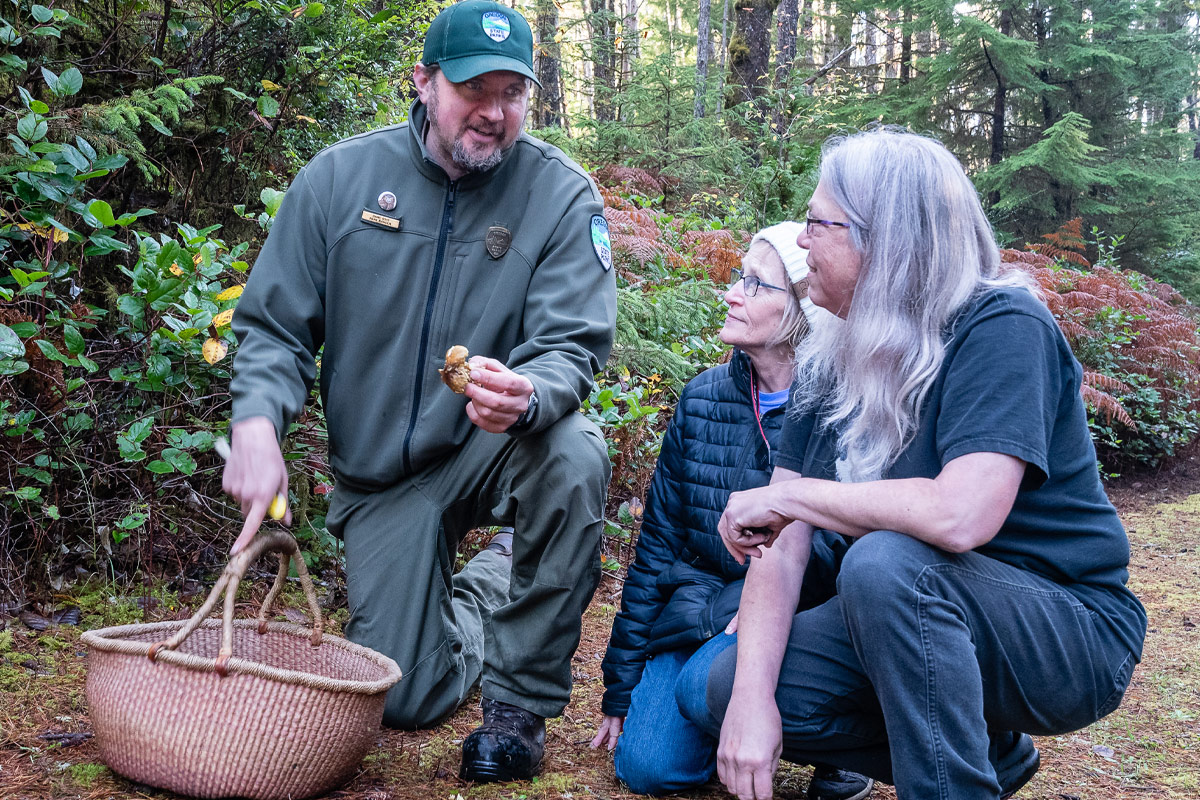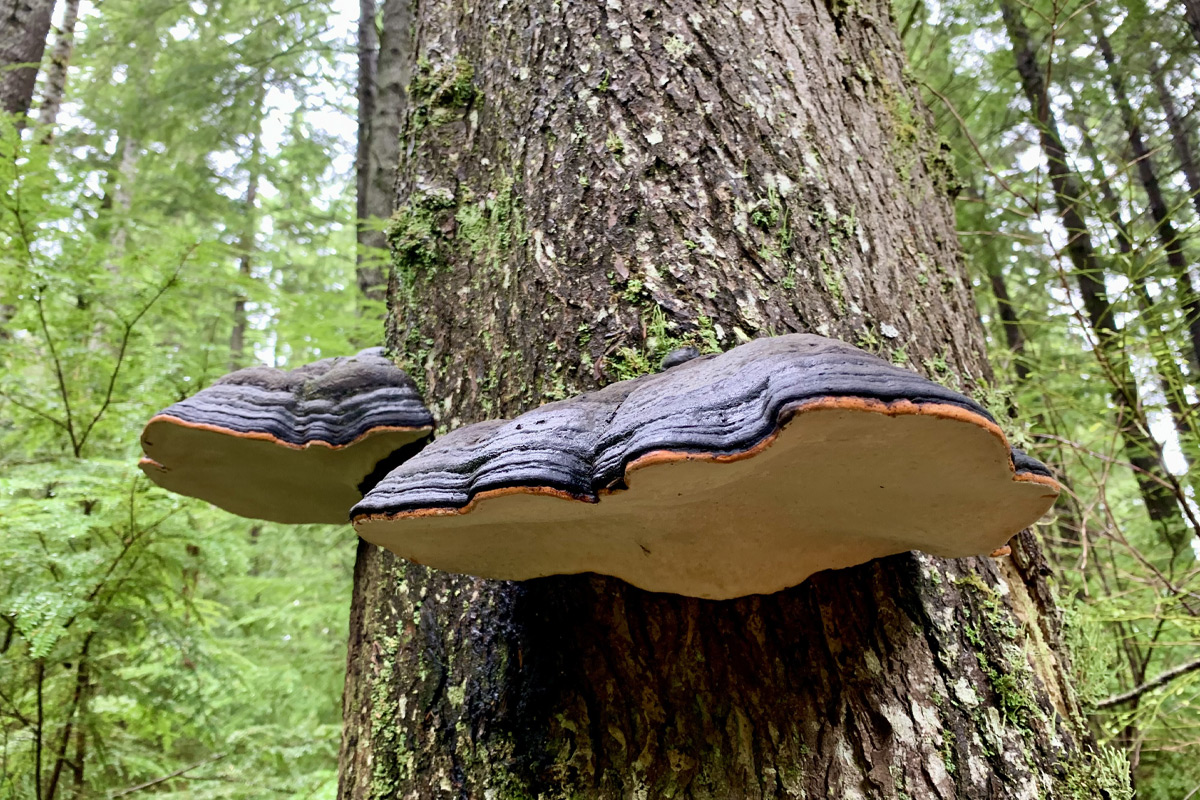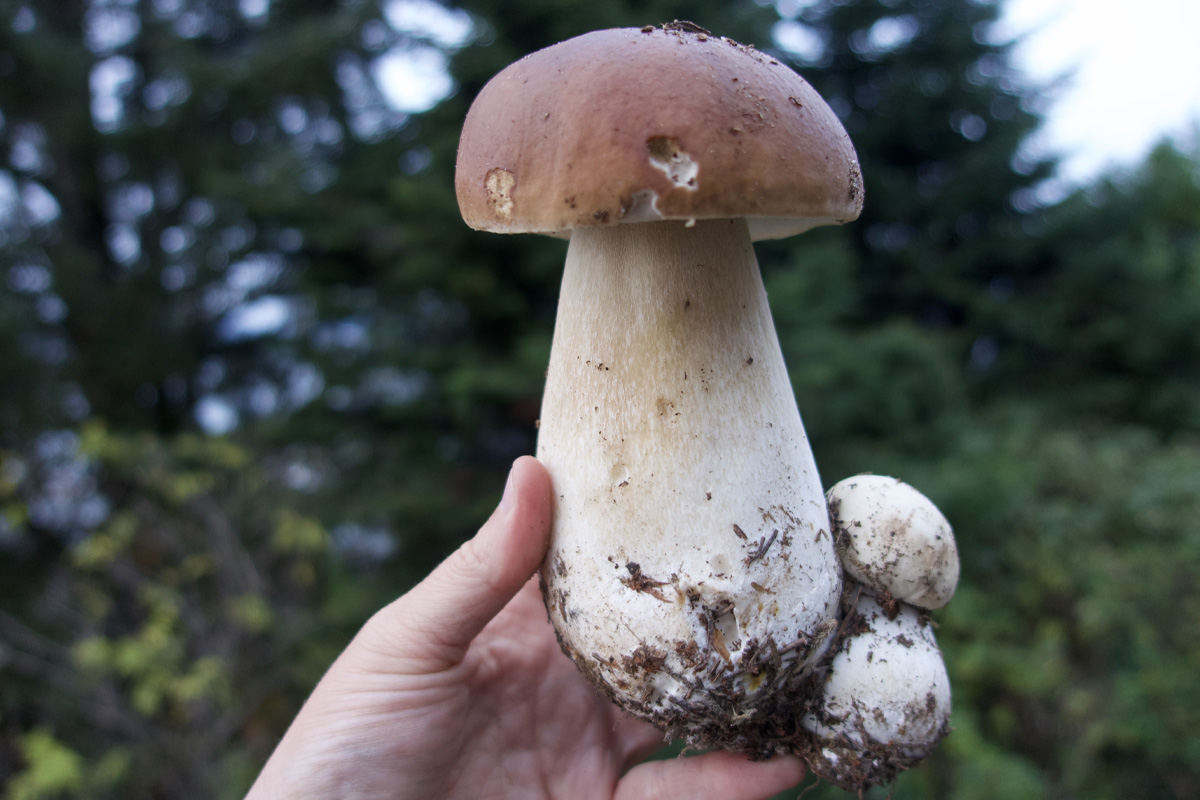Appreciating, foraging and sampling these spectacular fall treats.
If you ever see someone (like me) on their hands and knees among the shore pines on the Oregon Coast during the fall season, don’t worry. It’s likely they’re merely engaged in an ancient practice, the annual treasure hunt known as mushroom foraging. The Coast’s maritime climate with sandy soils and shady forests of the Coast Range make for prime territory for many wild mushrooms, both edible and nonedible. Here are a few ways to enjoy some of the fungi that flourish here.

Observing Cool Species on Trails
Observing mushrooms is really an activity anyone can do, even if you don’t want to pick or eat them. Some are tiny, some grow in strange shapes. Mushrooms often appear alongside trails or in grassy areas in parks, so even if you like to stick to flat terrain, you may find quite a few.
Park ranger Dane Osis, who leads mushroom identification walks and talks in Fort Stevens State Park near Astoria, suggests several types to spot but leave on the trail since many aren’t edible: Russulas, whose caps come in all shades of the rainbow (look for big purple and red ones), orange gymnopilus that grow out of wood “in massive clusters,” and the conk family, whose hard bodies grow like shelves from decaying trees. “Red-belted conks can be especially impressive,” he says, because of their size and the colorful bands around their margins.
And then there’s the famed fly agaric or Amanita muscaria, whose red cap with polka dots is familiar from folk tales. They grow well on the Coast and can often have umbrella-like tops in vibrant scarlet, orange or mustard yellow that can be 6 or more inches across. But every rose has its thorn: these cause vomiting and hallucinations when you eat them, so they’re better admired from a distance.

Finding Edible Wild Mushrooms
If you decide to try your hand at foraging edible mushrooms on the Oregon Coast, you’re in luck. It’s always best to begin with a local guide or class — try places like Southwestern Community College on the South Coast — and you’ll definitely want to buy one of several excellent Pacific Northwest mushroom field guides. The golden rule is do not eat anything you can’t identify with 100% certainty, as there are many toxic and downright poisonous species that look like common edibles.
Mushroom-foraging groups like the Oregon Mycological Society in Portland and the Cascade Mycological Society based in Eugene are very much worth joining if you’d like to gain enough knowledge to go out on your own. They educate and organize trips to the Coast and provide extensive resources for the public. (Both keep updated lists of print and online resources, walks and festivals in Oregon and beyond.)
Each fall local parks and community colleges across Oregon offer mushroom-foraging classes open to all. Groups like the Pacific Northwest Mushroom Identification Forum or the iNaturalist app provide reports and images of real-time findings in Oregon and Washington.
Always check the area in which you’re foraging for regulations about picking limits, prohibited areas and parking. This frequently updated guide to regulations is handy to understand the sometimes complicated rules about how much you can keep and when you can keep them.
“If you do your homework,” Osis says, “you’ll get to know some of the great mushrooms on the Coast.”

The Coast’s Common Edible Mushrooms
After taking a workshop, class or guided walk, the best way to identify edible mushrooms in the field is to use a guidebook. Since most foragers won’t share their secret spots, research the areas your targeted mushrooms prefer. Do not ever eat mushrooms you can’t positively identify. Most edible wild mushrooms need to be cooked thoroughly before eating to neutralize toxins.
One of the earliest and longest-appearing mushrooms in Oregon Coast forests is the chanterelle — a yellow or peachy-colored trumpet-shaped mushroom with a fruity odor that likes hillsides and hiding under logs. Several species with slightly different colors and shapes show up from July until November. Be careful, because there are several lookalikes that can make you sick. You’ll find them growing at the same time and in similar locations as hedgehog mushrooms, which have characteristic soft spines on the creamy underside of their bright salmon caps.
Oyster mushrooms are floppy, cream-colored mushrooms that grow in shelf formations on certain kinds of dead trees. You may see them near bright yellowy-orange chicken of the woods mushrooms, which grow in fan shapes on decaying wood.
Bright orange-red lobster mushrooms are always surprising to see poking out of the soil near the beaches. They’re actually a parasitized version of another mushroom that is completely white, and they can grow impressively large. Their name comes either from the color or scent of cooked seafood.
Perhaps even more impressive, king boletes with their hamburger-bun caps and squat stems can grow to 9 inches wide or more. Often called by their Italian name, porcini, these mushrooms are great grilled, in soup, or dried.
Matsutake or pine mushrooms — snowy-white, large mushrooms with an unusual funky and spicy scent especially prized by the Japanese — have been an important export for commercial pickers in Oregon. There are separate rules and limits for how to collect them, so be sure you know the regulations if you want to seek these out.
Enjoying Wild Mushrooms at Festivals
Fall mushroom festivals are also a fun way to experience the wide range of mushrooms celebrated on the Oregon Coast. Attendance is free, but expert-led walks may require a fee. Brookings hosts the Wild Rivers Mushroom Festival (November 5-6, 2022), with a great lineup of speakers, a mushroom display table with around 200 specimens and vendor booths with mushroom crafts and culinary goodies — all in prime mushroom territory in the state’s southwest corner. The Yachats Village Mushroom Festival (October 14-16, 2022) features guided walks, talks, identification help and themed menus in a quaint village on the Central Coast.
Wild mushrooms can also be purchased at farmers markets on the Coast each fall, and enjoyed at a number of Oregon Coast restaurants with farm-to-table menus.
More Advice for the New Forager
- Be 100% certain of any mushroom identification before eating it, since some common lookalikes are toxic or deadly.
- Some edible mushrooms don’t agree with particular stomachs. Only try a small bit the first time you cook any new fungus.
- Only pick on public property where harvesting is allowed. Know the rules for the place you plan to pick, including leash laws and parking permits.
- Observe limits for your haul, and harvest sustainably, leaving some mushrooms for animals to eat.
- Pick clean; if you brush off dirt and duff in the field, it makes cleaning mushrooms much easier at home.
- Dry-frying is a great way to neutralize the toxins present in many raw edible mushrooms. Clean your fungi, then chop, throw in a pan and saute until the liquid evaporates and they are fully cooked. Afterward, freeze in plastic bags or add to your favorite dishes.
– By Jennifer Burns Bright
in How-to



